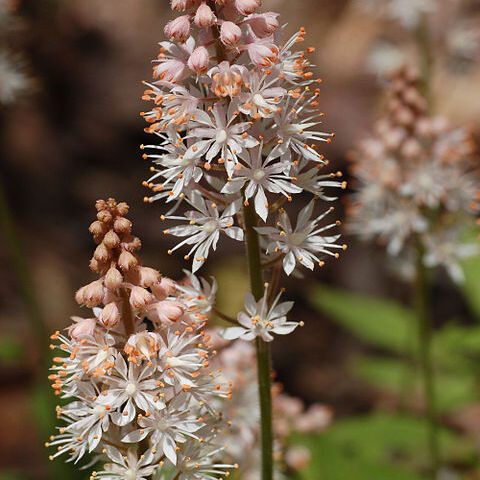Herbs (often evergreen), rhizomatous, sometimes stoloniferous; caudex creeping, scaly. Flowering stems erect, usually leafless, rarely with 1-2 leafy bracts, 10-70 cm, short to long glandular-stipitate. Leaves in basal rosette and, sometimes, cauline, simple or 3-foliolate; stipules present; petiole short to long stipitate-glandular (hairs usually denser distally, gland-tipped); blade cordate or broadly ovate, lobed, base cordate, margins crenate to dentate, apex acute, abaxial surface stipitate-glandular along veins, adaxial surface stipitate-glandular, sometimes appressed, hairs uniformly scattered; venation palmate. Inflorescences racemes (sometimes with paniculate branches at base) or panicles, terminal from axillary buds in rosette, 15-70-flowered, bracteate. Flowers radially symmetric or somewhat bilaterally symmetric; hypanthium barely adnate to ovary proximally, 0.2-0.9 mm free from ovary, white or pinkish, (campanulate); sepals 5, whitish or pinkish, (ovate to lanceolate, apex acute or obtuse, glandular-stipitate abaxially, glabrous adaxially); petals 5, white or pinkish to purplish; nectary disc absent or inconspicuous; stamens 10; filaments linear; ovary superior, 1-locular, carpels connate, unequal; placentation parietal; styles 2, (tapering); stigmas 2. Capsules 2-winged (beaked), unequally valvate, abaxial carpel 1.5-2 times longer than adaxial carpel, (papery, each wing 5-10-veined). Seeds black, shiny, ellipsoid or ovoid, (base truncate), puncticulate; (funicular appendage absent). x = 7.
More
Herbs perennial. Rhizome short, slender. Leaves mainly basal, cauline ones few, small; stipules small; leaf blade simple and trilobed or subtrifoliolate. Inflorescence a raceme or panicle, simple or sparsely branched; bracts small. Flowers small; hypanthium adnate to ovary at base. Sepals 5, usually petaloid. Petals 5, sometimes absent. Stamens 10, visible above corolla. Carpels 2, connate basally; ovary 1-loculed; placentation parietal; styles 2, slender, elongate. Fruit a capsule; carpels unequal, one ca. 1/2 as long as the other. Seeds few, black, small, smooth.
Fls perfect, 5-merous, regular or nearly so, barely perigynous; hypanthium small, campanulate; pet clawed, linear to elliptic; stamens 10; carpels 2, unequal, united below into a superior, unilocular ovary, distinct above; placentas parietal, near the base; rhizomatous herbs with broad, palmately veined, lobed basal lvs and an erect, usually lfless stem with a bracteate raceme or panicle of white fls. 1 Asia, 5 N. Amer.

